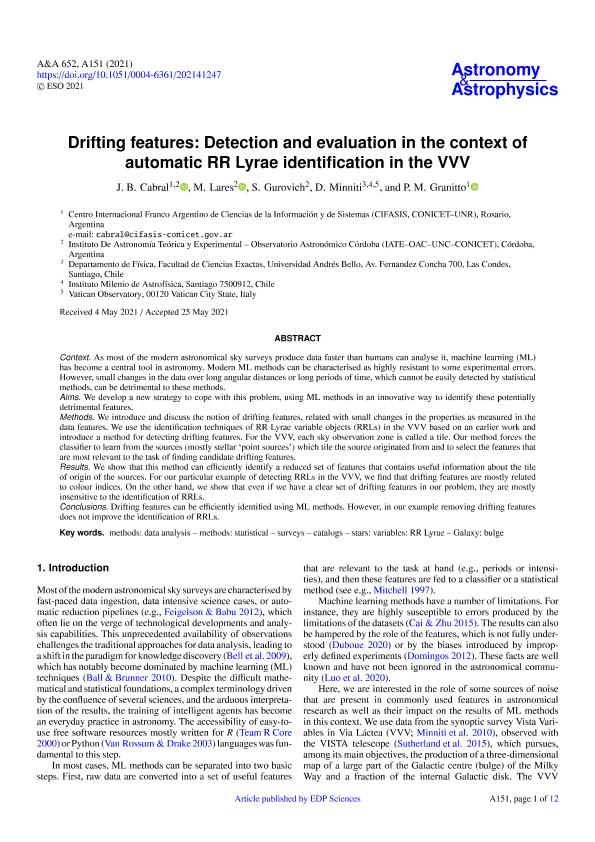Mostrar el registro sencillo del ítem
dc.contributor.author
Cabral, Juan Bautista

dc.contributor.author
Lares, M.
dc.contributor.author
Gurovich, Sebastian

dc.contributor.author
Minniti, D.

dc.contributor.author
Granitto, Pablo Miguel

dc.date.available
2022-12-30T01:26:41Z
dc.date.issued
2021-08
dc.identifier.citation
Cabral, Juan Bautista; Lares, M.; Gurovich, Sebastian; Minniti, D.; Granitto, Pablo Miguel; Drifting features: Detection and evaluation in the context of automatic RR Lyrae identification in the VVV; EDP Sciences; Astronomy and Astrophysics; 652; A151; 8-2021; 1-12
dc.identifier.issn
0004-6361
dc.identifier.uri
http://hdl.handle.net/11336/182876
dc.description.abstract
Context. As most of the modern astronomical sky surveys produce data faster than humans can analyse it, machine learning (ML) has become a central tool in astronomy. Modern ML methods can be characterised as highly resistant to some experimental errors. However, small changes in the data over long angular distances or long periods of time, which cannot be easily detected by statistical methods, can be detrimental to these methods. Aims. We develop a new strategy to cope with this problem, using ML methods in an innovative way to identify these potentially detrimental features. Methods. We introduce and discuss the notion of drifting features, related with small changes in the properties as measured in the data features. We use the identification techniques of RR Lyrae variable objects (RRLs) in the VVV based on an earlier work and introduce a method for detecting drifting features. For the VVV, each sky observation zone is called a tile. Our method forces the classifier to learn from the sources (mostly stellar 'point sources') which tile the source originated from and to select the features that are most relevant to the task of finding candidate drifting features. Results. We show that this method can efficiently identify a reduced set of features that contains useful information about the tile of origin of the sources. For our particular example of detecting RRLs in the VVV, we find that drifting features are mostly related to colour indices. On the other hand, we show that even if we have a clear set of drifting features in our problem, they are mostly insensitive to the identification of RRLs. Conclusions. Drifting features can be efficiently identified using ML methods. However, in our example removing drifting features does not improve the identification of RRLs.
dc.format
application/pdf
dc.language.iso
eng
dc.publisher
EDP Sciences

dc.rights
info:eu-repo/semantics/openAccess
dc.rights.uri
https://creativecommons.org/licenses/by-nc-sa/2.5/ar/
dc.subject
CATALOGS
dc.subject
GALAXY: BULGE
dc.subject
METHODS: DATA ANALYSIS
dc.subject
METHODS: STATISTICAL
dc.subject
STARS: VARIABLES: RR LYRAE
dc.subject
SURVEYS
dc.subject.classification
Otras Ciencias de la Computación e Información

dc.subject.classification
Ciencias de la Computación e Información

dc.subject.classification
CIENCIAS NATURALES Y EXACTAS

dc.title
Drifting features: Detection and evaluation in the context of automatic RR Lyrae identification in the VVV
dc.type
info:eu-repo/semantics/article
dc.type
info:ar-repo/semantics/artículo
dc.type
info:eu-repo/semantics/publishedVersion
dc.date.updated
2022-08-31T14:58:47Z
dc.journal.volume
652
dc.journal.number
A151
dc.journal.pagination
1-12
dc.journal.pais
Francia

dc.description.fil
Fil: Cabral, Juan Bautista. Consejo Nacional de Investigaciones Científicas y Técnicas. Centro Científico Tecnológico Conicet - Rosario. Centro Internacional Franco Argentino de Ciencias de la Información y de Sistemas. Universidad Nacional de Rosario. Centro Internacional Franco Argentino de Ciencias de la Información y de Sistemas; Argentina. Consejo Nacional de Investigaciones Científicas y Técnicas. Centro Científico Tecnológico Conicet - Córdoba. Instituto de Astronomía Teórica y Experimental. Universidad Nacional de Córdoba. Observatorio Astronómico de Córdoba. Instituto de Astronomía Teórica y Experimental; Argentina
dc.description.fil
Fil: Lares, M.. Consejo Nacional de Investigaciones Científicas y Técnicas. Centro Científico Tecnológico Conicet - Córdoba. Instituto de Astronomía Teórica y Experimental. Universidad Nacional de Córdoba. Observatorio Astronómico de Córdoba. Instituto de Astronomía Teórica y Experimental; Argentina
dc.description.fil
Fil: Gurovich, Sebastian. Consejo Nacional de Investigaciones Científicas y Técnicas. Centro Científico Tecnológico Conicet - Córdoba. Instituto de Astronomía Teórica y Experimental. Universidad Nacional de Córdoba. Observatorio Astronómico de Córdoba. Instituto de Astronomía Teórica y Experimental; Argentina
dc.description.fil
Fil: Minniti, D.. Universidad Andrés Bello; Chile. Vatican Observatory; Chile. Instituto Milenio de Astrofísica; Chile
dc.description.fil
Fil: Granitto, Pablo Miguel. Consejo Nacional de Investigaciones Científicas y Técnicas. Centro Científico Tecnológico Conicet - Rosario. Centro Internacional Franco Argentino de Ciencias de la Información y de Sistemas. Universidad Nacional de Rosario. Centro Internacional Franco Argentino de Ciencias de la Información y de Sistemas; Argentina
dc.journal.title
Astronomy and Astrophysics

dc.relation.alternativeid
info:eu-repo/semantics/altIdentifier/doi/http://dx.doi.org/10.1051/0004-6361/202141247
dc.relation.alternativeid
info:eu-repo/semantics/altIdentifier/url/https://www.aanda.org/articles/aa/full_html/2021/08/aa41247-21/aa41247-21.html
Archivos asociados
